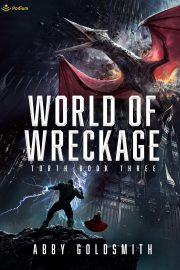Optimism is the New Bleak: How to Write with Hope
By Holly Schofield
Dystopian fiction seems to be built into the human psyche. Is it our default setting, or can we transform our collective narrative into a higher philosophy, a better way of thinking? These past couple of years of near-dystopia need to be overcome—as Spider Robinson says: let’s refute entropy.
It’s rare to see any form of media where the character arc is one of gaining non-futile hope. Just like we’ve added diversity, a sense of justice, and the climate emergency to SFF in recent years, can we add hope? Can optimism be the new “bleak”? I think it can.
Hopepunk was coined by Alex Rowland in 2017 as the antithesis of grimdark and dystopian fiction. It embodies the aesthetic of positivity and spans the broad spectrum of speculative fiction—yes, even horror. It’s a bandwagon whose time has come. As @AbrahamHanover tweeted, “In an age of performative cruelty, kindness is punk. Be as punk as f*ck.”
So how do you write hopeful narratives that reflect those social values? Optimism in fiction is considered cheesy, childish, or uncool. “Message fiction”—even with a focused environmental message that is hard to argue with—is considered didactic and preachy (and it can be, if mishandled). Let’s look at some techniques:
Subgenre Choice
We don’t write in a vacuum. We head for the SFF section of our local bookstore with expectations of content. By choosing a subgenre, we narrow that further. A steampunk story will have clockworks, a cyberpunk story will have cool tech, and a solarpunk story will have hope.
Derived from the trenchcoated-and-mirrorshades cyberpunk subgenre, solarpunk emphasizes environmental concerns, as well as Afrofuturism, Amazofuturism, and other resistance movements. In these stories, BIPOC, queer, disabled, neurodivergent, and other marginalized communities flourish and evolve into utopic scenarios. Recent articles from YES! Magazine, the BBC, and Vice attest to the new wave of sunshine spreading across all media.
It’s happening in our own fertile fields. Grist’s Fix solarpunk contest (read the winners here) attracted 1,100+ entries. Reckoning magazine started in 2016 and is going strong. Most major established SFF magazines have published Technogaianism stories in 2021, and new online publication Solarpunk Magazine‘s recent Kickstarter has been wildly successful. As writers know, if you build a market, writers and readers will come.
Textural Components
You can go for softer, more character-driven stories, like Becky Chambers’s The Long Way to a Small, Angry Planet, which The Guardian called “a quietly profound, humane tour de force that tackles politics and gender issues with refreshing optimism.”
Conversely, get harder. Alia Gee’s Suncatcher: Seven Days in the Sky piles problem after life-threatening problem onto its protagonist. Indrapramit Das’s short story, “A Necessary Being,” shows a high degree of physical and mental pain as giant mechas are left desolate after planting millions of trees. The gentle ending lands all the sweeter due to this extreme contrast.
Cooperative Outcomes
Another technique is to avoid the “lone hero” trope and illustrate communal problem-solving methods that actually work, as noted by Uncanny Magazine in Ada Palmer and Jo Walton’s essay “The Protagonist Problem.” Marie Vibbert’s “The Unlikely Heroines of Callisto Station” (Analog July/Aug 2021) is a good example: it’s all about group dynamics and successful collaboration.
Setting in Motion
Using setting to indicate mood is nothing new, but when it’s the local ecosystem the characters depend upon, it can be an active participatory character moving toward a brighter future. In L.X. Beckett’s fast-paced solarpunk mystery/romance “Cat Ladies” (Fantasy & Science Fiction, July/August 2021), the mobile rewilding unit—which provides both home and occupation to members of the community—is methodically moving through Calgary every second of the story, rehabilitating the suburbs back to prairie.
Create worlds that let the reader imagine them continuing for centuries to come, not collapsing from internal stresses after the last page. As one character in James Bradley’s Clade comments near that book’s end: “It is always a beginning.”
When you worldbuild a community that is working toward resilience and sustainability, you are imagining a better place. Spread that vibe! Let’s transform what John Clute calls “the ongoing SFF conversation” into a new and vibrant way forward. First SFF, then the world!
 Holly Schofield travels through time at the rate of one second per second, oscillating between the alternate realities of city and country life. She started writing in 2012 and has been a member of SFWA since 2016. Over 90 of her short stories are published in places like Analog, Lightspeed, Escap
Holly Schofield travels through time at the rate of one second per second, oscillating between the alternate realities of city and country life. She started writing in 2012 and has been a member of SFWA since 2016. Over 90 of her short stories are published in places like Analog, Lightspeed, Escap


